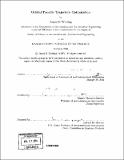Orbital transfer trajectory optimization
Author(s)
Whiting, James K., 1980-
DownloadFull printable version (3.282Mb)
Other Contributors
Massachusetts Institute of Technology. Dept. of Aeronautics and Astronautics.
Advisor
Manuel Martinez-Sanchez.
Terms of use
Metadata
Show full item recordAbstract
Recent developments in astronautical engineering have led to the adoption of low thrust rocket engines for spacecraft. Optimizing the orbital transfers for low thrust engines is significantly more complicated than optimizing transfers for impulsive engines because a continuous control law must be found and long integrations are necessary to determine whether the control law works or not. Previous work on optimizing low thrust orbital transfers has led to the development of control laws for continuous thrusting including the effects of oblateness, multiple attracting bodies, eclipses, and solar cell degradation. The current work adds to this by developing control laws for optimal coasting and for variable specific impulse at constant power. The Hamiltonian method is used to develop the optimal control laws and physical interpretations are given to each term in the Hamiltonian. Application of the optimal coasting control law to transfers from LEO to GEO indicate that small amounts of coasting can significantly reduce the fuel needed for a transfer.
Description
Thesis (S.M.)--Massachusetts Institute of Technology, Dept. of Aeronautics and Astronautics, 2004. Includes bibliographical references (p. 86-87).
Date issued
2004Department
Massachusetts Institute of Technology. Department of Aeronautics and AstronauticsPublisher
Massachusetts Institute of Technology
Keywords
Aeronautics and Astronautics.